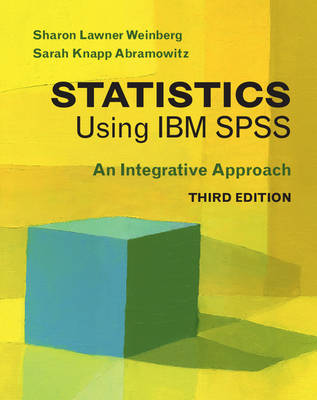'This is the third edition of a very popular and useful text. The focus is on using SPSS in the research process. The chapters have illustrative exercises and meaningful real data problem sets that not only make it convenient for teaching but also provide realistic experiences for students that will stay with them for many years. The book does a...
Read more'This is the third edition of a very popular and useful text. The focus is on using SPSS in the research process. The chapters have illustrative exercises and meaningful real data problem sets that not only make it convenient for teaching but also provide realistic experiences for students that will stay with them for many years. The book does a very good job presenting the challenge of data analysis and the experience of being a serious researcher looking at important problems; it illustrates how a variety of quantitative methods can be applied to real data to tease out and evaluate the inferences suggested by that data. I strongly recommend this book to instructors of a one- or two-semester introductory statistics course.' Robert W. Lissitz, University of Maryland 'This text by Weinberg and Abramowitz is an excellent choice for an undergraduate or introductory graduate course for non-majors. Stressing concepts over computation, it focuses on essential material for students in education and the social sciences. The book reads easily, like a set of well-constructed lectures that begin with simple fundamental concepts. Yet modern and relatively advanced topics, such as uses of the bootstrap, are also treated. Rather than focusing on hand calculations, the book integrates instruction on using SPSS directly into the text. This enables student exploration of actual research data sets, beginning in the first chapters.' James E. Corter, Columbia University 'This book covers a broad range of topics in introductory statistics, employing a hands-on, problem-based approach. The latest edition expands an already long list of topics to include bootstrap techniques and experimental design considerations. By providing detailed, worked-through examples based on real data and substantive research questions, the authors guide the student through the data analysis process from beginning to end. However, this is no 'cookbook' - each section builds on the concepts and techniques established previously, and the reader is encouraged to explore the nuances involved in effective statistical analysis. What is particularly unique about the authors' exposition is that it can be read on many levels; this book will serve well as a course textbook or as a handy reference for the applied researcher.' Marc A. Scott, New York University This is the third edition of a very popular and useful text. The focus is on using SPSS in the research process. The chapters have illustrative exercises and meaningful real data problem sets that not only make it convenient for teaching but also provide realistic experiences for students that will stay with them for many years. The book does a very good job presenting the challenge of data analysis and the experience of being a serious researcher looking at important problems; it illustrates how a variety of quantitative methods can be applied to real data to tease out and evaluate the inferences suggested by that data. I strongly recommend this book to instructors of a one- or two-semester introductory statistics course. Robert W. Lissitz, University of Maryland This text by Weinberg and Abramowitz is an excellent choice for an undergraduate or introductory graduate course for non-majors. Stressing concepts over computation, it focuses on essential material for students in education and the social sciences. The book reads easily, like a set of well-constructed lectures that begin with simple fundamental concepts. Yet modern and relatively advanced topics, such as uses of the bootstrap, are also treated. Rather than focusing on hand calculations, the book integrates instruction on using SPSS directly into the text. This enables student exploration of actual research data sets, beginning in the first chapters. James E. Corter, Columbia University This book covers a broad range of topics in introductory statistics, employing a hands-on, problem-based approach. The latest edition expands an already long list of topics to include bootstrap techniques and experimental design considerations. By providing detailed, worked-through examples based on real data and substantive research questions, the authors guide the student through the data analysis process from beginning to end. However, this is no 'cookbook' - each section builds on the concepts and techniques established previously, and the reader is encouraged to explore the nuances involved in effective statistical analysis. What is particularly unique about the authors' exposition is that it can be read on many levels; this book will serve well as a course textbook or as a handy reference for the applied researcher. Marc A. Scott, New York University
Read less
